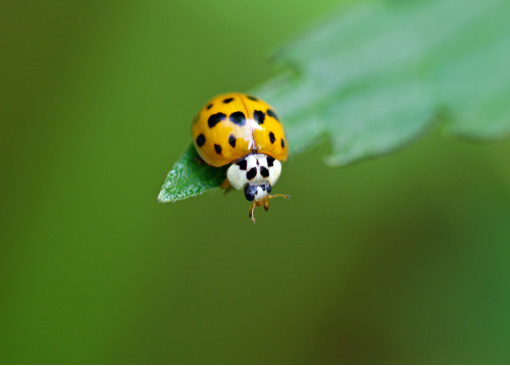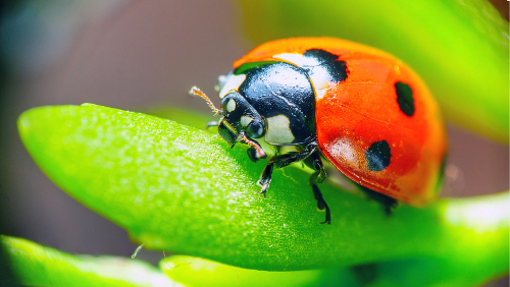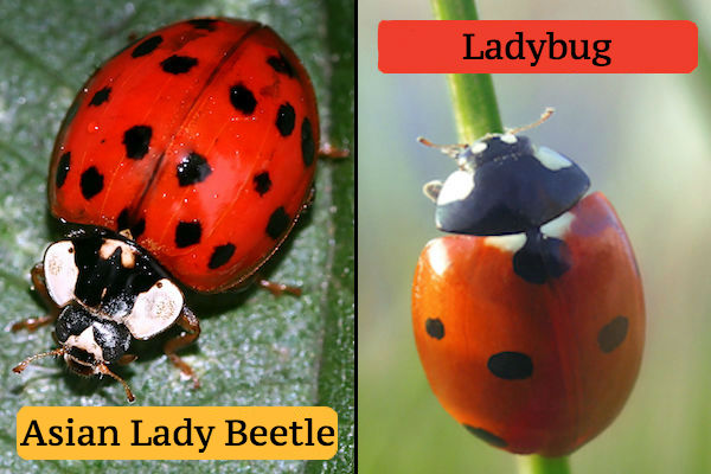The ladybug is a fan favorite. A few polka-dotted, red beetles in your garden during the springtime is a charming sight. But the cousin of the ladybug, the invasive Asian lady beetle, is less pleasant to have around your home.
Asian lady beetles seem to disguise themselves as harmless ladybugs in order to infiltrate our gardens and homes. They’re like the dastardly spies of the insect world, especially in fall and spring.
Thankfully, their disguise isn’t perfect. While it may not always be easy, telling the difference between Asian lady beetles and ladybugs is always possible. By figuring out which bug is which, you’ll be able to kick out the invaders and leave the native ladybugs. Here’s how to tell if you’re looking at a ladybug or an imposter and what to do about it.
Meet The Ladybug Look Alike: The Asian Lady Beetle
Are ladybugs and Asian beetles the same? No! Ladybugs and invasive Asian lady beetles may be part of the same insect family (coccinellidae), but they are very different bugs. When you get to know them, you’ll see that ladybugs and Asian lady beetles not only look different, but they also behave differently.
Are Ladybugs Harmful to Humans?
Ladybugs are considered highly beneficial, harmless insects. They don’t sting. And though they do rarely bite, it feels like a light pinch.
In fact, ladybugs are considered a helpful insect. They consume several harmful garden pests such as aphids, and can be a benefit to your garden. You won’t catch them congregating in large numbers, and they prefer to seek shelter outdoors when it gets cold. Ladybugs like to shelter in logs, under rocks, and under piles of leaves.
Are Asian Lady Beetles Harmful to Humans?
An Asian lady beetle is no match for humans, but they are an incredible nuisance. Asian lady beetles “bite” by scraping the skin they land on. And when they feel threatened, they may excrete a foul-smelling, yellow liquid from their leg joints. This excretion is called “reflex bleeding” and can also happen when they are crushed. Reflex bleeding isn’t dangerous or poisonous, but it can trigger minor allergic reactions. They can also stain walls or fabrics, damaging your property.
Are Asian Lady Beetles Harmful to Plants?
Similar to ladybugs, Asian lady beetles feed on aphids and other insects that munch on plants. Even though the invasive Asian lady beetle isn’t as friendly a sight as a ladybug, they can still be a friend to gardeners.
However, these bugs won’t bid a happy goodbye after gardening season is over. They’re prone to swarming, and prefer to overwinter inside homes. Once they’re finished feasting on aphids, they will crowd on reflective surfaces like windows and sliding glass doors. If they have the opportunity, Asian lady beetles will invade your home.
Asian Lady Beetle vs Ladybug: Spot the Difference
If you don’t look closely, Asian lady beetles and ladybugs can seem nearly identical. But a sharp eye can spot the subtle differences between them. This will help you welcome the friendly ladybug and stop Asian lady beetle invasions before they start.
There are several differences to watch out for, including appearance and temperaments. Here’s how to tell the two bugs apart:
Differences in Appearance Between Ladybugs and Asian Lady Beetles
Ladybugs and Asian lady beetles definitely look similar—but their size, color, and markings can help you tell the difference. If you’re examining beetles in your yard, check for these key differences:
- Size matters: Asian lady beetles are slightly larger than ladybugs. They’re about 7 mm long and 5.5 mm wide.
- Check the color: Ladybugs are bright red. The coloration of invasive Asian lady beetles varies. You might see Asian lady beetles that are red, orange, or even tan.
- Spot the spots: Ladybugs always have black spots on their wing covers, also called cerci. Asian lady beetles may or may not have black spots on their wing covers. No spots means that you have an Asian lady beetle in your garden.
- Examine their shape: Ladybugs have a more round shape while Asian lady beetles tend to be oval and a little longer.
- Look for the “M:” The easiest way to tell Asian lady beetles apart from ladybugs at a glance, though, is to look for the white “M.” Asian lady beetles have a distinctive, highly visible M-shaped black marking on their otherwise-white headsThis marking varies in size, thickness, and shape, but it’s always there.

This is a picture of an Asian lady beetle with the classic “M” marking on its head.

This is a picture of a ladybug with white markings only on the side of its head
You can see that a ladybug has a mostly black head. They also have small, white markings on sides of the head which look like cheeks! In general, ladybugs’ heads or “snouts” also appear shorter and less pointed than Asian lady beetles.

Behavior Differences Between Ladybugs and Invasive Asian Lady Beetles
The biggest difference of behavior is how they shelter in the winter. Ladybugs don’t sneak into your home the way Asian lady beetles do. While ladybugs overwinter in sheltered sites outdoors, Asian lady beetles often enter homes.
Asian lady beetles will gather in large groups, especially around warm, reflective surfaces like windows. The swarm can even find its way into your home. If you notice the bugs congregating in or around your home in fall or winter, they’re probably Asian lady beetles.
Other differences include biting. Asian lady beetles are biters while ladybugs very rarely bite. If you notice that the insects in your garden are nibbling on you, it’s probably the invasive Asian lady beetle.
Your nose can also tell you if you’re dealing with ladybugs or Asian lady beetles. Ladybugs won’t cause any odors, but Asian lady beetles secrete a yellow, foul-smelling scent. An unpleasant smell can tip you off to an Asian lady beetle invasion.
Paying attention to these subtle differences can tell you if you need ladybug pest control or Asian lady beetle pest control services.
Preventing and Getting Rid of Asian Lady Beetle Infestations
Now that you know more about Asian lady beetles, you probably want to keep these “false ladybugs” out of your home. Here’s how you can get rid of Asian lady beetles and free your home of imposters:
.png?r=Q+jf12Sw0BA=)
1. Find and seal cracks in your home. Asian lady beetles usually enter homes by accident. They congregate on window frames or wall spaces and end up wandering in through cracks. Cracks around windows, doors, eaves, and vents are some of the most common entrances for the invasive Asian lady beetle.
2. Fix and replace screens around your house. Holes in the screens on your windows and doors are welcome signs for the Asian lady beetle. By mending screens, you’ll be able to enjoy fresh air without sharing your home with invaders.
3. Don’t crush Asian lady beetles. They’ll let out the foul, yellow secretions that can damage or stain your property. Vacuum them up and dispose of the bag instead.
4. Scrub down their favorite haunts. Asian lady beetle swarms can leave behind smelly liquid that may attract even more beetles to your house. Clean it up with soapy water.
5. Try spraying citronella oil around your house. Asian lady beetles love sun-exposed and brightly colored surfaces. They are attracted to brightness and light colors. Spraying them down with a scent they dislike can keep them from settling on your property.
6. Place a few insect light traps around your house. These traps work best in dark places, like attics and basements. They attract Asian lady beetles with light and zap them when they get too close.
Pest Control Services to Get Rid of Asian Lady Beetles
If Asian lady beetles are swarming around your house, it’s time to call in extra help. Pest control services can keep those stinky troublemakers out of your home or business. Professionals use high-quality deterrents to shoo these ladybug imposters away and we’ll seal up openings in your home to make sure they never invade your house again.
Wondering why there are a bunch of ladybugs in your house? Need some help clearing out an Asian lady beetle infestation? Want to make sure you don’t get one in the first place? Just give Plunkett’s Pest Control a call. We’ll send those imposters packing, every time.







